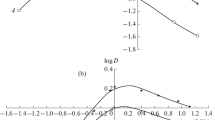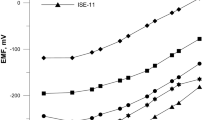Abstract
A new solvent polymeric membrane electrode based on pyrazolone heterocyclic Schiff base complexes of Co(II) is described. It shows a preferential response towards thiocyanate over a range of 2.0 × 10–6 to 1.0 × 10–1 mol L–1 with a slope of –60.2 ± 0.6 mV/dec. The selectivity sequence observed is thiocyanate > hydroxide > nitrite > iodide > perchlorate > citrate > bromide > fluoride > chloride > nitrate > acetate > borate > sulfate > phosphate. The selectivity behavior is discussed in view of axial coordination by uv/vis spectroscopy and the transfer process of thiocyanate across the membrane interface is investigated by the ac impedance technique. The electrode was successfully applied to the determination of thiocyanate in human urine as an indicator for distinguishing between smokers and non-smokers.
Similar content being viewed by others
Author information
Authors and Affiliations
Additional information
Received: 30 September 1997 / Revised: 9 December 1997 / Accepted: 13 December 1997
Rights and permissions
About this article
Cite this article
Ying, M., Yuan, R., Li, ZQ. et al. Thiocyanate-selective electrode based on cobalt(II) complexes of pyrazolone heterocyclic Schiff bases. Fresenius J Anal Chem 361, 437–441 (1998). https://doi.org/10.1007/s002160050921
Issue Date:
DOI: https://doi.org/10.1007/s002160050921




